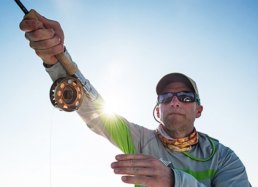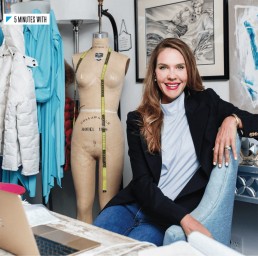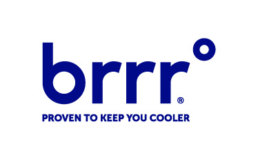Cooling Fabrics Are Becoming Really Cool by John McCurry
Companies involved in the development of fabrics that achieve a cooling effect are proliferating in the U.S. to meet demands by apparel makers and other manufacturers.
Some use unique construction to achieve cooling while others employ some kind of chemical additive. These products, most of which have been developed over the past few years, are advancing all along the supply chain, from fiber to chemical manufacturers to fabric developers.
Founded in 2014, Brrr is an Atlanta-based startup cooling-fabric company whose chemical-free technology is embedded into garments at the nanotech level.
Cofounder and Chief Executive Mary-Cathryn Kolb said Brrr’s technology is superior because it doesn’t involve chemicals. She is one of the inventors of the technology, which came about from research done at the University of Georgia, the University of Kentucky and the Massachusetts Institute of Technology.
Most cooling fabrics, she noted, are a lot of hype with the mechanics behind it being moisture wicking. Other ventures dip fabrics into chemicals, which are applied to the surface.
But Brrr’s technology has an all-natural mineral compound that acts as the cooling agent. “In suits or sheets or blankets, we feel we can do better and make them more comfortable and more pleasing in our everyday life,” Kolb said. “It’s part of the DNA of the fibers. They never wash out and never diminish.”
The company is currently producing fabric for men’s suits, women’s dresses, men’s dress shirts, undershirts, socks, underwear and bedding.
Brrr’s fabrics have achieved high ratings in tests conducted by the Hohenstein Institute in Germany, and the company was asked to be a charter member of Advanced Functional Fabrics of America, a nonprofit institute near the Massachusetts Institute of Technology and a member of the National Network of Manufacturing Innovation Institutes, which is trying to bring back manufacturing to the United States.
Also in the cooling-fabric business is Polartec, the longtime company known for its Delta product. Karen Beattie, the product manager who drove Delta’s development, said it is different because it helps provide real metabolic cooling for the life of the garment. She asserts that other technologies provide temporary or sensorial cooling or they can wash out over the life of a garment.
“It’s based on science, but it’s simple,” Beattie said. “Use fiber choice and fabric construction to amplify what our bodies do naturally to provide cooling. Evaporative cooling is the single biggest way our bodies dump excess heat when we sweat. We’ve constructed a fabric with hydrophilic yarns that hold just the right amount of sweat on your skin to experience prolonged evaporative cooling. The fabric also employs raised knit structures and highly breathable hydrophobic areas so you never get that clammy, sticky-shirt feeling.”
Delta products became commercially available for Spring 2017. Brands that have adopted it include Oiselle, Rhone, Outdoor Research and Fox Racing in the U.S. These are specialists in running, cycling and training garments.
In the fiber category, Israel-based Nilit is among the cool-category pioneers with its Breeze technology. The nylon 6,6 fiber came to the market about four years ago.
Molly Kremidas, the marketing manager at Nilit North America, said the goal with Breeze is to achieve comfort through moisture management. She said it is consistent with trends of lighter fabrics.
“We do create our own polymer with an additive inside the polymer that we can’t disclose,” Kremidas explained. “We developed this. We went to a laboratory in Belgium [Centexbel Textile Research Center] for testing. There’s not really a true standard in the industry right now on how to measure cooling.”
Breeze yarns feature a flat cross-section structure with a wide surface that transfers body heat. Kremidas said initial tests showed that Breeze resulted in a temperature change on the surface of 1-degree centigrade.
That was enough to impress two performance-apparel brands. Fast-forwarding a few years, ExOfficio launched a line using Breeze in both tops and bottoms. It’s also used in Adidas’ Climachill products, in Puma shoes and in Playtex intimate apparel. Kremidas notes that it has applications in knits, warp knits and wovens.
Coolcore, a company headquartered in Portsmouth, N.H., has been around a little longer, having been launched in 2011.
It is different in that its cooling effects are achieved by fabric construction rather than chemicals. Coolcore’s first products were cooling towels and ice wraps for medical uses, but it has gradually moved into an array of fabrics used in performance apparel.
The technology dates back to 2008 and was discovered purely by accident, said Kevin McCarthy, the company’s chief executive.
Coolcore’s chief technology officer, while working at Malden Mills on sublimation fabric for printing, discovered that the fabric evaporated moisture and created a cooling effect. This technology eventually became the basis for Coolcore.
Coolcore has working arrangements with a couple of mills to produce fabrics to its specifications. Either Coolcore or the mills buy specific yarns, and the mills either knit or weave the fabrics.
Link to original article: https://www.apparelnews.net/news/2018/feb/22/cooling-fabrics-are-becoming-really-cool/
brrr° featured in VoyageATL
Great Q&A with brrr° CEO Mary-Cathryn Kolb by digital magazine VoyageATL, in which she shares the story of brrr°'s growth and renewed focus on R&D as an ingredient brand.
brrr° CEO Mary-Cathryn Kolb Featured in Delta's Sky Magazine
brrr° is flying high with an exciting profile of CEO Mary-Cathryn Kolb in the December 2017 issue of Delta's Sky Magazine.
Delta Sky Magazine December 2017_brrr feature
Sourcing Journal writes about brrrº being chosen for inclusion in the Material Library maintained by Material ConneXion
sourcingjournalonline.com /outerwearworkwearfabricrdspikesnewperformancelevels/
Technical innovations that create highperformance fibers and fabrics continue to be at the forefront of product development in the textile industry.
From cooling and insulating materials for activewear to flame resistant, abrasion and impactresistant fabrics for durable workwear, companies are reaching new heights through collaborations, and with research and development.
DuPont Industrial Biosciences is collaborating with Unifi Inc., to create highperformance, renewably sourced garment insulation, offering apparel brands a new sustainable choice for coldweather products.
This partnership combines DuPont Sorona polymer and Unifi Repreve to produce coldweather apparel insulation that is soft and durable, with strong shape retention.
DuPont Sorona is made from 37 percent renewableplantbased ingredients, using 30 percent less energy with 63 percent fewer greenhouse gas emissions compared to nylon 6, the company noted. The soft hand, inherent stain resistance and durability of Sorona offers customers in a wide range of industries a more sustainable, highperformance materials option. The polymer has been used in everything from carpeting to Indian sarees.

Repreve is a highquality fiber containing recycled materials. Unifi’s proprietary process turns plastic bottles into certified fiber, which is then used in thousands of different fabrics and products available globally.
“The combination of Sorona and Repreve provides brands the opportunity to use a highperformance, durable insulation that dries quickly and keeps its shape even after washing,” said Michael Saltzberg, global business director for Biomaterials at DuPont. “The new insulation’s unique warmth and durability will bring customers streamlined outerwear, made from ecofriendly materials while maintaining maximum warmth and breathability.
[Read more about textile innovation: Textile Firms Put More Focus on Specialized Workwear Materials]
Ning Hongjun, president Unifi Asia Pacific, said the collaboration will give customers the freedom to choose a new type of garment insulation that is eco
friendly without compromising performance.
“With our expertise in recycled polyester staple fiber and DuPont Industrial Biosciences’ industryleading Sorona, we look forward to seeing this breakthrough technology be widely adopted by leading brands,” Hongiun added.
Teijin Aramid, a specialist in highperformance industrial fabrics, has introduced Teijinconex Coolnex Super Wicking Fabric, a lightweight, soft and comfortable flame resistant fabric.
Teijin, based in the Netherlands, said the outstanding feature of this new fabric is a quick dry absorption of perspiration without losing its flame resistance, an innovation that meant to fulfill the needs of the workwear industry.
The innovative single layer fabric combines the best in personal protection fabrics with high performance sports textiles, providing high levels of thermal protective performance against heat, flames and flash fire. Designed to breathe, the fabric allows the sweat to move from the body to outside, producing a cottonlike feel.
The fabric is reinforced with high performance Twaron or Technora paraaramid fibers for superior strength and durability. Garments made with Teijinconex Coolnex not only retain their protective properties after thermal exposure, but remain comfortable and service worthy longer.
“With our long history and experience in professional protective apparel and sportswear, we designed a fabric that brings comfort in flame resistant work wear to the next level,” Christian Norhausen, business department head of Heat & Cut protection at Teijin Aramid, said. “The intrinsically builtin flame resistance and moisture dry release properties make this an...outstanding fabric for everyday use.”
Cooling textile innovator brrr° was recently chosen for inclusion in the Material Library maintained by Material ConneXion, a unit of Sandow that consults with Fortune 500 companies on performance materials and design thinking.
Material ConneXion maintains one of the world’s largest subscriptionbased materials library with thousands of innovative materials and processes, and its research division works with companies to strategically incorporate trends and innovation into their business models and products.
Brrr° fabrics were recognized as having the “innate qualities that our team of material scientists and specialists look for when adding a material to our library of advanced, innovative and sustainable materials,” Material ConneXion said about the inclusion of brrr° fabrics in its fullservice libraries in New York, Bangkok, Milan, Tokyo, Bilbao, Spain, and Daegu, South Korea, plus certain satellite and educational libraries around the world.
Brrr° uses a proprietary blend of natural cooling minerals embedded in yarn, superior moisture wicking and a patented knitting and weaving process that maximizes airflow to create a “triple chill effect.” This gives brrr° fabrics Qmax cooling scores that are 30 to 85 percent better than the scores of comparable virgin nylon, polyester or cotton, and the cooling effect of brrr° has also been independently lab tested and validated by the prestigious Hohenstein Institute.
This content is for Annual, Monthly and Limited members only. You can read up to five free articles each month with a Limited Level Subscription. Please log in, or register.
Log In Register
Textile World writes about brrr°'s acceptance in the Venture Atlanta Startup Showcase
 ATLANTA — September 15, 2017 — Cooling textile innovator brrr° was chosen to present and showcase its patented fabrics at the 10th annual Venture Atlanta elite investor conference and innovation showcase.
ATLANTA — September 15, 2017 — Cooling textile innovator brrr° was chosen to present and showcase its patented fabrics at the 10th annual Venture Atlanta elite investor conference and innovation showcase.
brrr° is one of only 16 startups deemed to have “the most exciting emerging technologies in the Southeast” selected to present at Venture Atlanta’s Startup Showcase, which gives investors a sneak peek into the products and services being developed by up-and-coming firms.
According to the company, brrr° uses a proprietary blend of natural cooling minerals embedded in yarn, superior moisture wicking and a patented knitting or weaving process that maximizes airflow to create a “triple chill effect.” This gives brrr° fabrics Qmax cooling scores that are 30 to 85 percent better than the scores of comparable “virgin” nylon, polyester or cotton, and brrr°’s cooling effect has also been independently lab tested and validated by the prestigious Hohenstein Institute.
“We are honored and humbled to be among this elite group of innovators invited to Venture Atlanta’s Startup Showcase,” said Mary-Cathryn Kolb.
Venture Atlanta is one of the largest and most respected investor conferences in the Southeast, attracting nearly 150 investment funds and drawing a sold-out crowd of 900 attendees. This year’s event, to be held Oct. 11-12 at the College Football Hall of Fame in Atlanta, will feature Mark Cuban, an investor and philanthropist and owner of the NBA’s Dallas Mavericks, and Carvana CEO Ernie Garcia.
Over the years, Venture Atlanta has helped launch more than 380 companies that secured in excess of $2 billion in funding, including Acculynk (acquired by First Data), CloudSherpas (acquired by Accenture), Joulex (acquired by Cisco), SilverPOP (acquired by IBM), Kabbage, SalesLoft, and Roadie.
Source: brrr°





